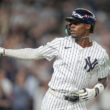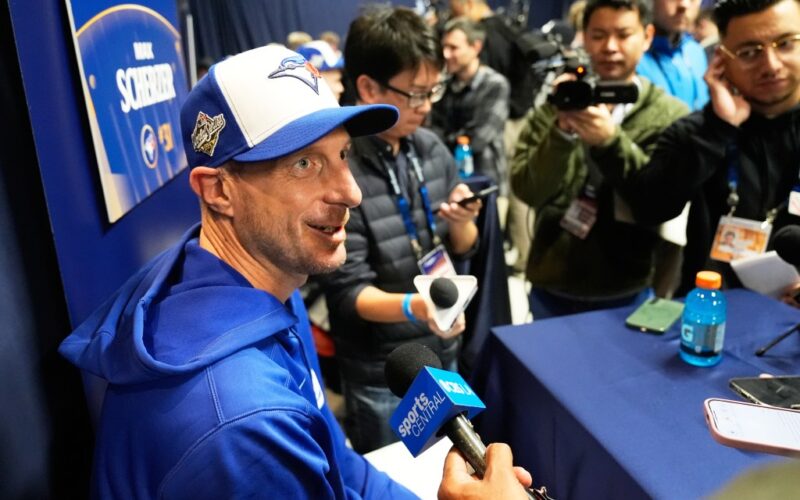The day after he starts, Max Scherzer arrives early to the ballpark to do something that fewer and fewer pitchers do these days: He runs.
The veteran right-hander runs from foul pole to foul pole along the outfield wall. When he was with the Mets, he was sometimes seen running around Citi Field, passing the Jackie Robinson Rotunda entrance and the Shea Stadium home run entrance before going underneath the subway tracks, hanging a left on Roosevelt Avenue before heading back to the clubhouse on Seaver Way.
It’s old-school.
It’s how pitchers recovered after starts for years, attempting to flush the build-up of lactic acid from their prized pitching arms. Now, pitchers train for explosive movements that could better mimic the stop-and-start movement on the mound. They’ve mostly stopped running foul poles after starts.
Not Scherzer, though. The 41-year-old Toronto Blue Jays starter has maintained some of his old-school ways while still adapting to younger, stronger hitters since making his big league debut in 2008.
In a postseason full of pitching stars who are doing things with the baseball that few could have ever imagined, two pitchers in the World Series are in a category all of their own. Scherzer and Los Angeles Dodgers left-hander Clayton Kershaw aren’t just first-ballot hall-of-famers, they’re the last in a generation of truly great aces.
It’s not that baseball doesn’t have aces anymore. On the contrary, in terms of pure skill and stuff, pitching might be better now than ever, and the World Series will only serve to highlight that.
Left-hander Blake Snell, owner of a 0.86 postseason ERA and two Cy Young Awards, will start Game 1 for the Dodgers, while rookie flamethrower Trey Yesavage will counter for the Blue Jays in front of a home crowd at Rogers Centre. There’s Kevin Gausman and Shane Bieber for Toronto, and Tyler Glasnow and Yoshinobu Yamamoto for the Dodgers. Not to mention, Shohei Ohtani, who also stands in a category all of his own, but for different, more unicorn-like reasons.
But what we know as an “ace” in 2025 is far different than it was when Scherzer and Kershaw were drafted in 2006. Back then, frontline starters were consistently making 30 starts and throwing 200 innings. They were relied upon to go seven innings every five days, and throw more than 100 pitches. In today’s game, pitchers throw fewer innings, giving a maximum effort for a shorter duration to maintain velocity.
Quality starts have been diminishing since 2014. That year, six teams received 100 or more from their starting staff. It was two in 2015 and two in 2016. Since then, no staff has combined for 100 or more. The Philadelphia Phillies led the league with only 84 this season.
With the elbow injury epidemic, front offices have to be cautious with their arms. Tommy John surgery doesn’t seem to be an if anymore, it’s almost a matter of when.
Only three active pitchers have won more than 200 games, Scherzer, Kershaw and Justin Verlander. Yankees ace Gerrit Cole is No. 4 on MLB’s active wins leader list with 153. Pitcher wins might not be as valuable as they once were, but we may not see another 300-game winner for a long time — if ever.
Randy Johnson was the last pitcher to win 300 games, doing so in 2009 at 38, a year old than Kershaw was this season.
There are nine Cy Young Awards won between the two World Series pitching staffs this year, three each by Kershaw and Scherzer. Their careers have been defined by dominance since the beginning.
Watching the two of them pitch is like watching an artist at work on a canvas. Kershaw paints with consistent brush strokes, while Scherzer is a little more like Jackson Pollock with his violent delivery. Yet it’s that delivery that has been the culprit behind the neck and injuries Scherzer has dealt with throughout his career. He missed a start in the 2019 World Series with neck and back spasms, and was removed from his 2023 World Series start with back tightness. Still, his teams won both of those series.
Kershaw already announced his retirement at the conclusion of the season. He’s had shoulder surgeries, one as recently as last fall, knee injuries, a bone spur in his toe and pelvic inflammation. Age comes for us all.
It’s come for many of their peers, like Tim Lincecum, another 2006 draftee, and Lincecum’s former teammate with the San Francisco Giants, Madison Bumgarner. It’s come for Felix Hernandez, Adam Wainwright, Corey Kluber, CC Sabathia and Scherzer’s former Washington Nationals teammate Stephen Strasburg.
DeGrom, Yu Darvish, Zack Wheeler, Nathan Eovaldi and Chris Sale, all 35 or older, are still hanging on, but for how much longer? Paul Skenes and Tarik Skubal are ushering in a new generation of aces. They have exceptional stuff and throw exceptionally hard. Skubal has come close to throwing 200 innings twice, so maybe there’s hope for the future of starting pitching production after all.
Still, Scherzer and Kershaw facing off against one another in the World Series is almost poetic. It’s two of the best to ever do it, marking the end of an era of starting pitching era we may never see again.








